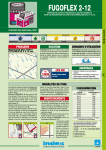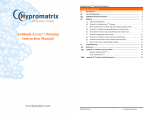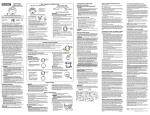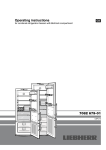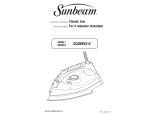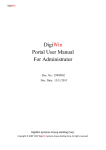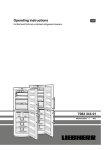Download Krups G VS2 41 ice cream maker
Transcript
NOTICE europe 15/09/04 11:44 Page a1 NOTICE europe 15/09/04 11:44 Page a2 A B C D E F G H GVS1 GVS2 NOTICE europe 15/09/04 11:44 Page a3 1 2 3 4 ❹ ❶ ❷ ❸ 5 6 8 9 7 NOTICE europe 15/09/04 11:44 Page 1 - Si le cordon d’alimentation de l’appareil est endommagé, il ne doit être réparé que par un Centre Service Agréé KRUPS exclusivement, afin d’é viter tout danger. Français Merci d’avoir choisi une sorbetièr e KRUPS destinée à réaliser de délicieuses préparations glacées. Description Consignes de sécurité A Bloc moteur avec indicateur marche/arrêt B Couvercle C Pale D Anneau supérieur E Bol réfrigérant F Anneau inférieur G Couvercle souple (sur modèle GVS2) H Spatule (sur modèle GVS2) - Veuillez lire attentivement ces instructions avant d’utiliser l’appareil. - La tension indiquée sur la plaque d’identification doit correspondre à celle de l’alimentation secteur. - Ne pas poser l’appareil sur une surface chaude, plaque chauffante par exemple, et ne pas l’utiliser ou le laisser à proximité d’une flamme nue. - Ne jamais immerger le bloc moteur dans l’eau. - Ne pas porter le bol réfrigérant à une température supérieure à 40°C. Ne pas le mettre dans un lave-vaisselle, un four ou un four micro-ondes et ne pas le remplir d’un liquide chaud. - Débrancher la prise secteur en cas d’anomalie de fonctionnement et avant chaque ouverture de couvercle. - Ne jamais introduire les doigts ou un ustensile dans l’orifice de remplissage. - Toujours débrancher la prise secteur de l’appareil après utilisation, et avant de procéder à son nettoyage. - Ne pas laisser le cordon d’alimentation sur les bords ou les coins d’une table ou d’un plan de travail. - Ne jamais débrancher la prise secteur en tirant sur le cordon d’alimentation. - Ne pas utiliser l’appareil si le cordon d’alimentation ou l’appareil luimême est endommagé. - Cet appareil ne peut pas être utilisé sans assistance ni surveillance par des enfants ou des personnes dont les capacités physiques, sensorielles ou mentales les empêchent de l’utiliser en toute sécurité. Cet appareil n’est pas un jouet, ne le laissez pas à la portée des enfants. Instructions de démontage pour le nettoyage et avant la première utilisation 1) Tournez le couvercle en sens inverse des aiguilles d’une montre pour le déverrouiller puis soulevez-le (Fig. 1). Enlevez le bloc moteur situé dans le bol réfrigérant et mettez-le de côté. 2) Démontez l’anneau supérieur en actionnant un des leviers sur la poignée (Fig. 2). Utilisez l’autre main pour démonter l’anneau supérieur. 3)Démontez l’anneau inférieur en actionnant les DEUX leviers de la poignée et en appuyant vers le bas (Fig. 3) 4) Nettoyez toutes les pièces en suivant les instructions ci-après. Nettoyage avant la première utilisation : 1) Avant d’utiliser l’appareil, il convient de le nettoyer pour éliminer tout résidu éventuel de fabrication. 2) Ne jamais immerger le bloc moteur dans l’eau. L’essuyer simplement avec un chiffon humide. 1 NOTICE europe 15/09/04 11:44 Page 2 3) Nettoyez le bol réfrigérant, le couvercle, les anneaux et la pale à l’eau tiède. La spatule et le couvercle souple, sur le modèle Réf.GVS2, peuvent également être nettoyés à l’eau tiède. 4) Ne NETTOYEZ JAMAIS les pièces avec des produits abrasifs ou durs. Vous pourriez les endommager. 5) Séchez avec précaution toutes les pièces avant utilisation. b) Fixez le bloc moteur sur le couvercle et insérez la pale dans le bloc moteur (Fig. 5). Veillez à ce que le bloc moteur soit bien fixé. c) Mettez le couvercle (avec le bloc moteur et la pale) au-dessus du bol et tournez dans le sens des aiguilles d’une montre pour le verrouiller (Fig. 6). Attention à ce que les quatre ver rous soient bien enclenchés. 5) Branchez la sorbetière et faites la fonctionner immédiatement pour éviter que la pale ne gèle dans le bol très froid. L’indicateur s’allume. 6) Toujours verser la préparation dans l’appareil par l’orifice de remplissa ge (Fig. 7). Si vous souhaitez incor porer d’autres ingrédients en cours de solidification du mélange, ver sez-les délicatement par l’orifice. 7) Lorsque la consistance désirée est obtenue, arrêtez l’appareil et débranchez la prise secteur. Selon la recette, la quantité de glace et la température initiale, la durée de préparation est comprise entre 20 et 40 minutes. 8) Pour ne pas solliciter le moteur, l’appareil modifie le sens de rotation lorsque la masse devient trop compacte. Si cela se répète sans interruption, la préparation glacée est prête. Arrêtez l’appareil en appuyant sur l’interrupteur marche/arrêt. Le voyant s’éteint. Débranchez-le. Préparation de la glace, des yaourts glacés et des sorbets 1) Retirez les anneaux du bol réfrigérant. Laissez le bol vide refroidir pendant au moins 24 heures dans un congélateur à une températur e de –18°C, en s’assurant que le bol est parfaitement sec à l’intérieur comme à l’extérieur. Le bol doit être placé à l’endroit pour permettre une bonne répartition du liquide retenu entre les parois au moment de sa solidification. 2) Préparez le mélange à glace (voir la partie recettes). S’il s’agit d’un mélange chaud, le refroidir au préalable dans le réfrigérateur (mini mum 12 heures). 3) En raison de l’augmentation de volume lors de la préparation, la quantité du mélange ne doit pas dépasser 1 Kg pour les sorbets ou 1 litre pour les crèmes glacées (fig. 8). 4) Commencez par assembler les éléments en laissant l’appareil hors tension. a) Montez l’anneau inférieur ; vous devez entendre un “clic” puis enclenchez l’anneau supérieur sur le bol réfrigérant. Assurez-vous qu’ils soient bien fixés (Fig. 4). Modèle GVS2 - Le modèle GVS2 est muni d’un affi cheur digital et livré avec une spatu le et un couvercle souple. L’écran digital contrôle la progression de la préparation de la crème glacée; il émet un petit bip et s’éteint auto matiquement lorsque la préparation est prête. Appuyez sur l’inter rup teur marche/arrêt, le voyant s’é teint. Débranchez l’appareil. 2 NOTICE europe 15/09/04 11:44 Page 3 9) Retirez le couvercle en soulevant légèrement le bloc moteur et en tournant dans le sens inverse des aiguilles d’une montre. Retirez la pale. Démontez le bloc moteur en appuyant sur les 2 repères situés sur les côtés (Fig. 9). 10) L’utilisation d’ustensiles métalliques pourrait abîmer le bol réfrigérant. Utilisez uniquement une spatule en bois ou en plastique pour retirer la glace. Sur le modèle Réf. GVS2, utilisez la spatule four nie avec le produit. 11) Vous pouvez maintenir la glace dans le bol réfrigérant pendant plusieurs minutes avant de la servir ou bien la placer dans le congélateur pour la rendre plus dure. Pour la conserver utilisez un autre récipient pourvu d'un cou vercle ; sur le modèle Réf. GVS2, placez directement le couvercle souple sur le bol réfrigérant en ayant préalablement retiré les anneaux. Instructions de nettoyage 1)Démontez l’appareil. 2)Seuls le couvercle (sans le bloc moteur) et la pale peuvent être mis dans le rack supérieur du lave-vaisselle. - Sur le modèle GVS2, la spatule et le couvercle souple peuvent égale ment être mis au lave-vaisselle. 3)Le bol et les anneaux seront nettoyés à l’eau de vaisselle tiède (pas d’eau chaude). 4)Le bloc moteur ne peut pas passer au lave-vaisselle. Nettoyez-le simplement avec un chiffon humide. 5)Ne jamais nettoyer les pièces avec des poudres détergentes car vous pourriez les endommager. 6)Séchez le bol soigneusement avant de le remettre au congélateur (sans les anneaux). Produit électrique ou électronique en fin de vie Votre appareil est prévu pour fon tionner durant de longues années. Toutefois, le jour où vous envisagez de le remplacer, ne le jetez pas dans votre poubelle ou dans une décharge mais apportez le au point de collecte mis en place par votre commune (ou dans une déchetterie le cas échéant). Sécurité - Le produit est équipé d’un élément de sécurité qui arrête automatique ment l’appareil en cas de surchauffe du moteur. Cette surchauffe peut advenir si le dessert est très épais et si l’appareil a fonctionné pendant une période de temps excessivement longue ou si des ingrédients que l’on a ajoutés (noix…) sont en très gros morceaux. Pour remettre l’appareil en marche : appuyez sur l’interrupteur marche/arrêt ; laissez l’appareil refroidir. Après quelques minutes, vous pouvez le remettre en fonctionnement. Ne laissez pas l’appareil fonctionner plus longtemps que cela est nécessaire. Conseils et suggestions 1)Les préparations de glace contenant une forte proportion de sucre, de matières grasses ou d’alcool demandent plus de temps pour se solidifier ou peuvent ne pas devenir fermes. 2)Ajouter de l’alcool uniquement lorsque l’appareil fonctionne et que la préparation est déjà à moitié solidifiée. ATTENTION : Ne pas faire fonctionner la sorbetière à l'intérieur du congélateur ou du réfrigérateur. 3 NOTICE europe 15/09/04 11:44 Page 4 3) Nous vous recommandons de prépa rer les ingrédients avant de retirer le bol du congélateur (afin que le bol soit aussi froid que possible au départ). 4) Au démarrage, toute préparation versée dans le bol réfrigérant doit être liquide. Ne pas utiliser d’ingré dients fermes, tels que de la crème fouettée ou des liquides déjà glacés pour la préparation de la glace. 5) Préparez la veille et conservez au réfrigérateur les préparations nécessitant une cuisson préalable (minimum 12 heures). GLACE AU CHOCOLAT 250 ml de lait entier (35% de matière grasse),100 g de sucre 80 g de cacao, 1 oeuf (calibre 60) ,450 g de crème liquide (30% de matière grasse) 1 cuillère à café d’extrait de vanille. 1. Mélangez le lait, l’œuf et le sucre dans une petite casserole. 2. Faites chauffer le mélange à feu doux sans bouillir, tout en remuant jusqu’à ce qu’il commence à épaissir et prenne la consistance d’une crème anglaise légère. 3. Versez ensuite le cacao tout en remuant jusqu’à ce que le mélange soit homogène. 4. Laissez refroidir à température ambiante. 5. Ajoutez en remuant la crème et la vanille. 6. Mettez au réfrigérateur (minimum 12 heures). Recettes GLACE A LA VANILLE 250 ml de lait entier (35% de matière grasse),100 g de sucre, 2 oeufs (calibre 60), 450 g de crème liquide (30% de matière grasse) 1 cuillère à café d’extrait de vanille GLACE A LA NOIX DE COCO 250 ml de lait entier (3.5% de matières grasses), 150 g de sucre, 2 œufs (calibre 60), 450 g de crème liquide (30% de matières grasses) 40 g de noix de coco séchée 1/2 cuillère à café d’extrait de vanille 1. Faites chauffer le lait dans une petite casserole tout en fouettant les œufs et le sucre dans un bol à part. 2. Versez lentement le lait chaud sur les œufs et le sucre mélangés, tout en remuant. 3. Versez le tout dans la casserole et faîtes chauffer le mélange sans bouillir, tout en remuant jusqu’à ce qu’il commence à épaissir et prenne la consistance d’une crème anglaise légère. 4. Laissez refroidir à température ambiante. Ajoutez la crème et l’essence de vanille en mélangeant. 5. Mettez au réfrigérateur (minimum 12 heures) 1. Mélangez le lait, l’œuf, le sucre dans une petite casserole. 2. Faites chauffer le mélange à feu doux, sans bouillir, tout en remuant jusqu’à ce qu’il commence à épaissir et prenne la consistance d’une crème anglaise légère. 3. Laissez refroidir à température ambiante et ajoutez la noix de coco, la crème et la vanille toute en remuant. 4. Mettez au réfrigérateur (minimum 12 heures) Variantes : - Dissoudre 2 cuillères à café de café instantané dans la préparation chaude. - Remplacer la vanille par 2 cuillères à café de sirop à la menthe. 4 NOTICE europe 15/09/04 11:44 Page 5 GLACE RHUM ET RAISINS GLACE AU YOGOURT ET AUX FRUITS ROUGES 120 de raisins secs, 100 ml de rhum Versez le rhum sur les raisins secs et laissez reposer à couvert toute une nuit. 250 ml de lait entier (35% de matière grasse),100 g de sucre ,2 oeufs (calibre 60) ,450 g de crème liquide (30% de matière grasse) 100g de fraises, 100 g de framboises 100 g de myrtilles, 250g de yogurt nature, 110 g de sucre 1. Lavez les fruits rouges et réduisez les en purée à l’aide d’un mixer. 2. Mélangez le sucre et le yogourt dans un bol jusqu’à dissolution du sucre. 3. Mélangez la purée de fruits tout en remuant. 1. Faites chauffer le lait dans une petite casserole tout en fouettant les œufs et le sucre dans un bol à part. 2. Versez lentement le lait chaud sur les œufs et le sucre mélangés, tout en remuant. 3. Versez le tout dans la casserole et faites chauffer le mélange sans bouillir, tout en remuant jusqu’à ce qu’il commence à épaissir et prenne la consistance d’une crème anglaise légère. 4. Laissez refroidir à température ambiante. 5. Ajoutez la crème en remuant et mettre au réfrigérateur (minimum 12 heures). 6. Ajoutez les raisins imbibés de rhum lorsque l’appareil fonctionne et dès que la préparation commence à prendre de la consistance. SOUFFLE GLACE A LA FRAISE 400 g de fraises, 3 jaunes d’oeuf, 60g de sucre, 200 g de babeur re 1. Lavez les fraises et réduisez les en purée à l’aide d’un mixer. 2. Faites chauffer à feu doux les jaunes d’œuf et deux cuillères à soupe de purée de fraises dans une petite casserole jusqu’à ce que le mélange devienne friable. 3. Battez le mélange d’œufs et le reste de la purée dans un bol froid jusqu’à ce que le mélange soit homogène. 4. Versez ensuite le sucre et le babeurre tout en remuant. 5. Placez la préparation dans le réfrigérateur pour qu’elle refroidisse (minimum 12 heures). GLACE AU YOGOURT ET AU CITRON 300 g de yogurt nature, 3 cuillerées à soupe (50g) de crème fraîche épaisse (42% de matières grasses), 170 g de sucre, 250 ml de jus de citron. SORBET A L’ORANGE 200 g de sucre, 300ml d’eau, 400 ml de jus d’orange 1. Mélangez bien le yogourt, la crème, et le sucre jusqu’à dissolution complète du sucre. 2. Ajoutez le jus de citron tout en remuant. 1. Mélangez l’eau et le sucre dans une casserole et portez à ébullition. 2. Laissez le sirop refroidir à température ambiante. 5 NOTICE europe 15/09/04 11:44 Page 6 3. Versez le jus d’orange en remuant et placez la préparation dans le réfrigérateur pour qu’elle refroidisse (minimum 12 heures). B. On peut ajouter à cette préparation de base : - 3 bananes réduites en purée (environ 350 g) - 100 g d’amandes grillées - 100 g de noisettes brisées - 120 g de vermicelles ou de pépites de chocolat. Variantes : On peut utiliser du jus de citron ou de pamplemousse ou des kiwis en purée (dans ce cas, ajoutez une cuillère à soupe de jus de citron). SORBET AU PAMPLEMOUSSE ET AU MIEL 175 g de miel, 450 ml de jus de pamplemousse 1. Laissez tiédir à feu doux le miel dans une petite casserole et versez-y 4 cuillerées de jus tout en remuant. 2. Mélangez ensuite cette préparation avec le jus restant dans un bol à part. 3. Placez la préparation dans le réfrigérateur pour qu’elle refroidisse (minimum 12 heures). Préparation à la carte A. Préparation de base 500 ml de lait,4 jaunes d’oeuf, 1 cuillère à café (8 g) de farine de maïs 100 g de sucre 1. Portez le lait à ébullition dans une casserole. 2. Battez les jaunes d’œufs, le sucre et la farine dans un bol jusqu’à ce que le mélange soit pratiquement blanc. 3. Versez le lait chaud sans cesser de remuer. 4. Mettez dans la casserole et chauffez jusqu’à épaississement léger sans porter à ébullition. 5. Laissez refroidir et mettez au réfrigérateur (minium 12 heures). 6 NOTICE europe 15/09/04 11:44 Page 25 - This product has been designed for domestic use only. Any commercial use, inappropriate use or failure to comply with the instructions, the manufacturer accepts no responsibility and the guarantee will not apply. English Thank you for choosing an ice-cream maker from the KRUPS range to help make delicious ice-creams and sorbets. Safety instructions HELPLINE: - Carefully read the instruction leaflet before first using the appliance. - Check that your appliance's power supply rating on the identification plate corresponds to your mains electrical supply. - Do not place the appliance on a hot surface (a hot-plate, for example) or leave it near an open flame. - Do not immerse the motor unit in water. - Do not heat the cooling jug to a temperature of more than 40°C. Do not put in a dishwasher, oven or microwave oven and do not fill with a hot liquid. - Unplug from the mains power supply if the appliance fails during operation and each time you open the lid. - Never put your fingers or a utensil in the filling hole. - Always unplug your appliance when you stop using it and before cleaning it. - Do not let the power supply cord hang over the edges or corners of a table or work surface. - Never pull the power cord to disconnect the appliance. - Do not use the appliance if the power supply cord or the appliance itself are damaged. - This appliance must not be used by children or persons whose physical, sensorial or mental capabilities prevent them from using it in complete safety without assistance.This appliance is not a toy. Do not leave in reach of children. - If the appliance’s power supply cord is damaged, it must only be replaceby a KRUPS approved centre so as to avoid any hazard. If you have any product problems or queries, please contact our Customer Relations Team first for expert help and advice: 0845 602 1454 - UK (01) 4751947 - Ireland or consult our website www.krups.co.uk Description A Motor unit with ON/OFF indicator B Lid C Paddle D Upper ring E Cooling jug F Lower ring G Flexible lid (on model GVS2) H Spatula (on model GVS2 Disassembly instructions for cleaning and before first use 1) Turn the lid anti-clockwise to unlock it then lift it out (Fig. 1). Remove the motor unit located under the jug and set it aside. 2) Disassemble the upper ring by acting on pushing or pressing on one of the levers on the handle (Fig. 2). Remove the upper ring with your other hand. 3) Disassemble the lower ring pushing or pressing on BOTH levers of the handle, pressing downwards (Fig. 3). 4) Clean all the parts in accordance with the following instructions. 25 NOTICE europe 15/09/04 11:44 Page 26 b) Secure the motor unit to the lid and slot the paddle into the motor unit (Fig. 5). Make certain the motor unit is securely attached. c) Place the lid (with the motor unit and the paddle) on the jug and turn clockwise to lock it (Fig. 6). Make certain that the 4 locks are properly engaged. 5) Connect the ice cream maker and run it immediately to avoid the paddle freezing up in the extremely cold jug. The light will come on. 6) Always pour the preparation into the ice-cream maker through the filling hole (Fig. 7). If you wish to blend in other ingredients as the mix freezes, pour them in through the hole slowly. 7) Once you have obtained the desired consistency, turn off the appliance and unplug it. It will take between 20 and 40 minutes to make the preparation according to the recipe, the quantity of ice cream and initial temperature. 8) So as not to put strain on the motor, the appliance will change the direction of rotation when the mix becomes too compact. If this occurs repeatedly, this means the ice cream preparation is ready. Press the ON/OFF button to turn the appliance off. The light will go off. Cleaning before first use 1) Before using the ice-cream maker, clean it to eliminate any residues from manufacturing. 2) Never immerse the motor unit in water. Just clean it with a moist cloth. 3) Clean the cooling jug, lid, rings and paddle with warm water. On model Ref. GVS2, you can also clean the spatula and flexible lid in warm water. 4) NEVER clean parts with abrasive or harsh products. You could damage them. 5) Carefully dry all parts before use. Preparing ice cream, iced yoghurts and sorbets 1) Remove the rings from the cooling jug. Make certain that the jug is perfectly dry inside and out before leaving the empty jug to cool for at least 24 hours in a freezer at a temperature of –18°C. Make sure the jug is upright to ensure an even distribution of the liquid between the walls when it freezes. 2) Prepare the ice cream mix (see recipes section). First cool in the refrigerator for at least 12 hours if it is a hot mix. 3) As the mix will increase in volume during preparation, do not exceed 1 Kg of mix for sorbets and 1 litre for ice creams (Fig. 8). 4) Make certain the appliance is unplugged and start assembling the components. a) Assemble the lower ring (you should hear a clicking noise as it snaps into place). Then fit the upper ring onto the cooling jug. Make certain they are cor rectly secured (Fig. 4). Model GVS2 Model GVS2 is equipped with a digital display and delivered with a spatula and flexible lid. The digital screen checks progress of the ice cream pre paration. Once the ice cream is ready, the appliance will stop automatically and let you know by emitting a beep noise. Press the ON/OFF switch. The light will go off. Unplug the appliance. 26 NOTICE europe 15/09/04 11:44 Page 27 9) Remove the lid, raising the motor unit slightly and turning anti-clock wise. Remove the paddle. Disassemble the motor unit pressing down on the 2 marks on the sides (Fig. 9). 10) Using metal utensils could damage the cooling jug. Only use a wooden or plastic spatula to remove the ice cream. If you have model Ref. GVS2, use the spatula provided with the product. 11) You can keep the ice cream in the cooling jug for several minutes before serving or place it in the freezer to make it harder. To keep it, use another container provided with a lid. If you have model Ref. GVS2, first remove the rings, then place the flexible lid directly on the cooling jug. - On model GVS2, the spatula and flexible lid can also be washed in the dishwasher. 3) The jug and rings can be cleaned in warm washing up water (do not use hot water). 4) The motor unit must not be washed in the dishwasher. Just wipe it with a moist cloth. 5) Never clean the parts with detergent powders, as this could damage them. 6) Dry the jug carefully before putting it back in the freezer (without the rings). Electrical product at end of service life Your appliance is designed to run for many years. However, the day you decide to replace it, do not throw it in your dustbin or take it to a dump but take it to the collection point provided by your local authority (or to a waste-collection site, as appropriate). Safety features - The product is equipped with a safety device that stops the appliance automatically if it overheats. Overheating may occur if the dessert you are preparing is very thick and if the ice-cream maker runs for too long or if the ingredients added (e.g. walnuts, etc.) are not chopped finely enough. To start the ice-cream maker again, press the ON/OFF button and let it cool down. After a few minutes you can start it up again. - Do not run the ice-cream maker longer than necessary. Hints and suggestions 1) Ice cream preparations containing a high proportion of sugar, fatty matter or spirits require more time to freeze or may even not stiffen. 2) Only add spirits once the appliance ice-cream maker is running and the preparation is already half frozen. 3) We advise you to prepare the ingredients before taking the jug out of the freezer so that the jug will be as cold as possible on startup. 4) On start-up, any preparation poured into the cooling jug must be liquid. Do not use stiff ingredients like whipped cream or already frozen liquids to prepare the ice cream. CAUTION: Do not run the ice cream maker inside the freezer or the refrigerator. Cleaning instructions 1) Disassemble the appliance. 2) Only the lid (without the motor unit) and the paddle can be washed in the upper rack of the dishwasher. 27 NOTICE europe 15/09/04 11:44 Page 28 5) Prepare the previous day and keep preparations that first need to be cooked in the refrigerator for at least 12 hours. 3. Sprinkle in the cocoa powder stirring all the while until the mix becomes even. 4. Allow to cool at room temperature. 5. the cream and vanilla and stir in. 6. Put into the refrigerator for at least 12 hours. Recipes VANILLA ICE CREAM COCONUT ICE CREAM 250 ml full-cream milk (35% fat), 100 g sugar, 2 medium eggs, 450 g liquid cream (30% fat) 1 teaspoons vanilla essence 150 ml full-cream milk (35% fat), 100 g sugar, 2 medium eggs, 450 g liquid cream (30% fat), 40 g dried coconut, 1/2 teaspoons of vanilla essence. 1. Heat the milk in a small saucepan while beating the eggs and sugar in a jug separately. 2. Slowly pour the hot milk onto the mixed eggs and sugar while stirring. 3. Pour all the mixture into the saucepan and heat it without boiling but stirring all the while until it starts to thicken like smooth custard. 4. Allow to cool at room temperature, then add the cream and vanilla essence and mix. 5. Put into the refrigerator for at least 12 hours 1. Mix the milk, egg and sugar in a small saucepan. 2. Gently heat the mixture without boiling while stirring until it starts to thicken like smooth custard. 3. Allow to cool at room temperature and stir in the coconut, cream and vanilla. 4. Put into the refrigerator for at least 12 hours RUM AND RAISIN ICE CREAM 120g raisins, 100 ml rum Pour the rum onto the raisins, cover and leave to stand all night. 250 ml full-cream milk (35% fat), 100 g sugar, 2 medium eggs, 450 g liquid cream (30% fat) Variations: - Dissolve 2 teaspoons of instant coffee in the hot preparation. - Replace the vanilla with 2 teaspoons of mint syrup. 1. Heat the milk in a small saucepan while beating the eggs and sugar in a jug separately. 2. Slowly pour the hot milk onto the mixed eggs and sugar while stirring. 3. Pour all the mixture into the saucepan and heat it without boiling but stirring all the while until it starts to thicken like smooth custard. 4. Allow to cool at room temperature. 5. Mix in the cream and put the mix in the refrigerator for at least 12 hours. 6. Add the rum-soaked raisins as soon as the preparation starts to thicken as you run the appliance. CHOCOLATE ICE CREAM 250 ml full cream milk (35% fat), 100 g sugar 80 g cocoa powder, 1 medium egg, 450 g liquid cream (30% fat) 1 teaspoons of vanilla essence. 1. Mix the milk, egg and sugar in a small saucepan. 2. Gently heat the mixture without boiling while stirring until it starts to thicken like smooth custard. 28 NOTICE europe 15/09/04 11:44 Page 29 YOGHURT AND LEMON ICE CREAM 2. Let the syrup cool down to room temperature. 3. Stir in the orange juice and place the preparation in the refrigerator for at least 12 hours for it to cool. 300 g natural yoghurt, 3 tablespoons (50g) of double cream (42% fat), 170 g sugar, 250 ml lemon juice. Variations: 1. Thoroughly mix the yoghurt, cream and sugar until the sugar has been completely dissolved. 2. Add the lemon juice while stirring. You can use lemon or grapefruit juice or mashed kiwis (for the latter, also add a tablespoon of lemon juice). GRAPEFRUIT AND HONEY SORBET YOGHURT AND RED-FRUIT ICE CREAM 175 g honey, 450 ml grapefruit juice 100g strawberries, 100 g raspberries 100 g bilberries, 250g natural yoghurt, 110 g sugar 1. Gently warm the honey in a small saucepan and stir in 4 spoonfuls of juice. 2. Then mix this preparation with the remaining juice separately in a jug. 3. Put the preparation in the refrigerator for it to cool for at least 12 hours. 1. Rinse the red fruit and use a blender to make them into a soup. 2. Mix the sugar and yoghurt in a jug until the sugar has been completely dissolved. 3. Stir in and mix the fruit soup. “A LA CARTE PREPARATION“ STRAWBERRY ICE CREAM SOUFFLE A- Basic preparation 400 g strawberries, 3 egg yolks, 60g sugar, 200 g buttermilk 500 ml milk, 4 egg yolks, 1 teaspoon coffee, 8 g corn flour, 100 g sugar 1. Bring the milk to boil in a saucepan. 2. Beat the egg yolks, sugar and corn flour in a bowl until the mix is almost white. 3. Pour in the hot milk while stirring continuously. 4. Put the mix into the saucepan and heat without boiling until it thickens slightly. 5. Leave to cool and put in the refrigerator for at least 12 hours. 1. Rinse the strawberries and use the blender to make them into a soup. 2. Gently heat the egg yolks with two tablespoons of strawberry soup in a small saucepan until the mix becomes crumbly. 3. Beat the mix of eggs and the remainder of the soup in a cold jug until the mix is even. 4. Then stir in the buttermilk. 5. Put in the refrigerator to cool for at least 12 hours. B- You can add the following to this basic preparation: - 3 mashed bananas (about 350 g) - 100 g toasted almonds - 100 g chopped hazelnut - 120 g vermicelli or chocolate chips. ORANGE SORBET 300 g sugar, 300ml water, 400 ml oran ge juice 1. Mix the water and sugar in a saucepan and bring to the boil. 29
This document in other languages
- français: Krups G VS2 41















